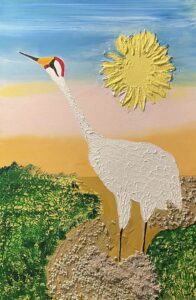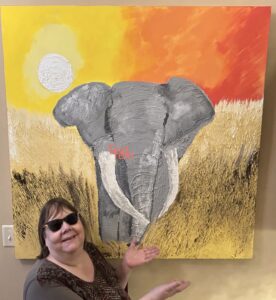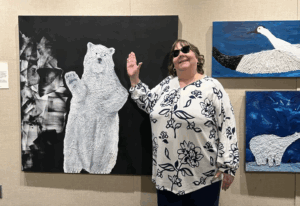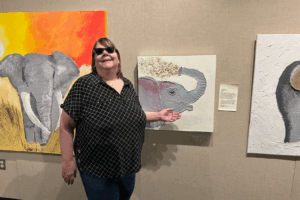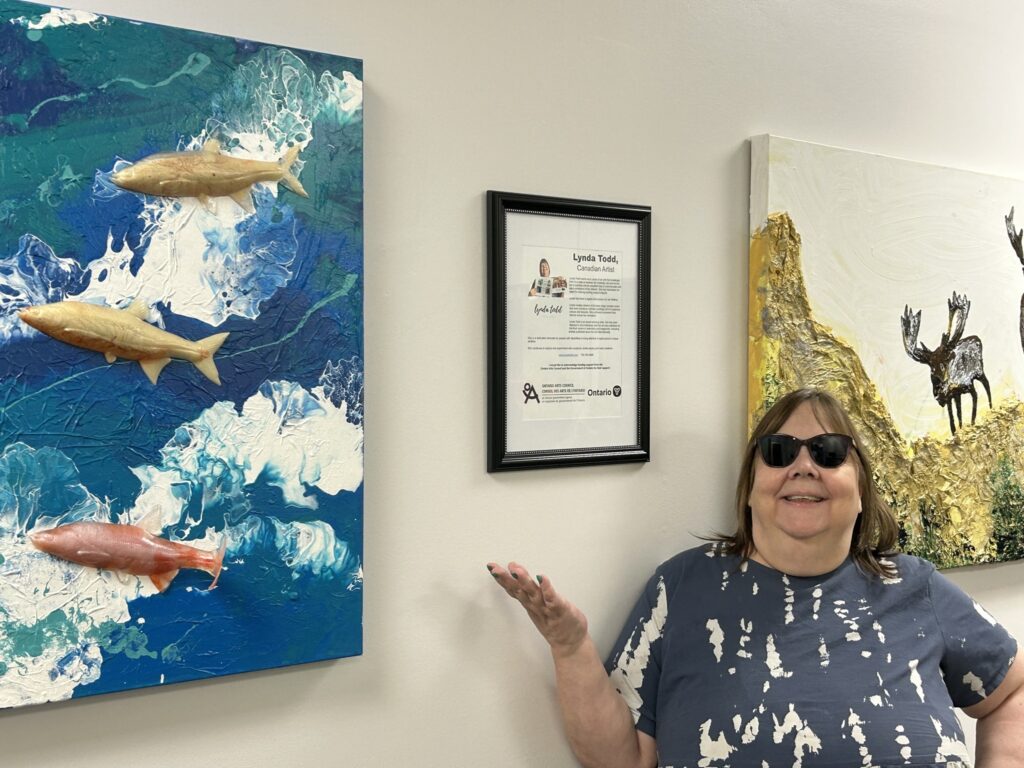How Lynda Todd is Redefining Accessibility in the Art World
Five years ago, Lynda Todd never imagined she had become a professional artist, let alone one with a growing list of solo exhibitions solo exhibitions and national and international recognition as she had never picked up an art brush before then.
Visually impaired and colour-blind, Lynda admits she believed painting would be a frustrating and futile pursuit. But today, she is leading a quiet revolution in the Canadian art scene by creating tactile, fully accessible exhibits that invite everyone to experience art—literally—through touch.
It all began with a workshop through the Active Together program, which Lynda helps run.
Valerie Kent, a friend and gallery curator, encouraged her to attend a fluid art session “just for fun.” She left with six abstract pieces that stunned everyone.
One solo show led to another, and Lynda was soon recognized for her raw talent and bold, textural approach to painting.
But a moment of exclusion changed the course of her artistic journey. During her first solo exhibit, a blind friend asked her to describe the artwork—a request that left Lynda feeling helpless and frustrated. “How do you describe abstract art to someone who’s never seen colour?” she remembers thinking. It just did not sit right with me.”
That moment planted a seed. Lynda began experimenting with texture and layers, exploring materials like resin and modelling paste to give her canvases a tactile dimension. She applied for a grant from the Ontario Arts Council. She created her first accessible exhibit, Migration: Land, Air, Sea, featuring butterflies, salmon, and caribou—each brought to life with touchable textures, large-print and Braille descriptions, and QR codes offering audio descriptions.
“I wanted people to feel welcome—not just to see the art, but to experience it,” says Lynda.
Her exhibit Migration 2 focused on migratory animals like sea turtles and whooping cranes, drew more than 1,400 visitors to the Belleville John M. Parrott Gallery and was hailed by the Canadian National Institute for the Blind (CNIB) as the first 100% accessible exhibit they had ever seen.
Walter Dickinson, CNIB Next Generation Program Lead, who arranged for a bus load of CNIB members from Toronto to attend the exhibit, shares his thoughts:
“Thank you for doing what you do and being fearless in your pursuit of creativity. You will inspire the youth and kids I work with, and your work will show them that their creative efforts matter.
“I am thrilled to bring attention to the vulnerability of migratory and endangered species. Art has the power to spark important conversations, and I hope Migration: Change and Challenge inspires action to protect our planet and its inhabitants,” says Todd. “By combining accessibility with environmental awareness, I want to show how connected we all are, and how urgent it is to address climate change and the challenges these species face.”
Lynda’s connection to Spinal Cord Injury Ontario (SCIO) is just as personal. Alec Denys, a Paralympian and longtime SCIO member, was one of her first supporters and close friends. His feedback—especially on the importance of hanging art at a height accessible to wheelchair users—helped Lynda evolve her work further. She also added audio description.
“Witnessing Lynda’s evolution as an artist has been inspiring. Her journey is remarkable from her early paintings to her vibrant pours and now her richly textured, tactile works. What truly sets her apart is her commitment to accessibility—integrating braille, texture, and a ‘please touch’ approach to ensure everyone can experience her art. Lynda is not just creating art; she is reshaping how we connect with it,” stated Denys.
From autism to vision loss to mobility disabilities, Lynda’s exhibits are built with everyone in mind. “It’s not just about making art accessible,” she says. “It’s about changing how we think about inclusion—about who gets to enjoy creativity and culture.”
Lynda is a lifelong learner. She is grateful to all who have mentored her for their positive feedback and invaluable suggestions. She is responsive to accessibility needs. We expect further great art from Lynda, “states artist and Juror Valerie Kent
Now working on her third exhibit in the Migration series (think polar bears, penguins, and whales), Lynda dreams of taking her work across Canada as a travelling exhibit. She is also collaborating with VocalEye, to explore even more ways to make accessible art a national standard.
Her goal? “I want accessibility in art galleries to become common place, not a novelty.”
“I dream of taking my textured, touchable art on a cross-Canada journey—creating a travelling exhibit that challenges galleries to embrace full accessibility. I want art to be inclusive for all, inviting everyone to connect and beyond sight. It is time to break barriers and engage every sense,” says Lynda.
With every textured brushstroke and Braille label, Lynda Todd is doing just that: reshaping the art world into something more beautiful, inclusive, and human.
Below a few of Lynda’s pieces.
Lynda Todd is an award-winning mixed-media artist based in Peterborough, Ontario. A commitment to accessibility and inclusion drives her work. Legally blind and colour-blind, Lynda strives to break down barriers within the art world, creating tactile and multi-sensory pieces that can be experienced by everyone, regardless of ability. Through her innovative approach and passion for universal design, she hopes to inspire a more inclusive and compassionate arts community where everyone feels welcomed, valued, and connected with the power of art. She makes her art accessible not just by making it tactile, but she also provides audio description, large print and braille description cards and has the galleries hang her art lower so that wheelchair users can touch the pieces easily.
To see more of Lynda’s work visit her website www.lyndatodd.com
Lynda’s social media https://www.facebook.com/LyndaToddArtist
